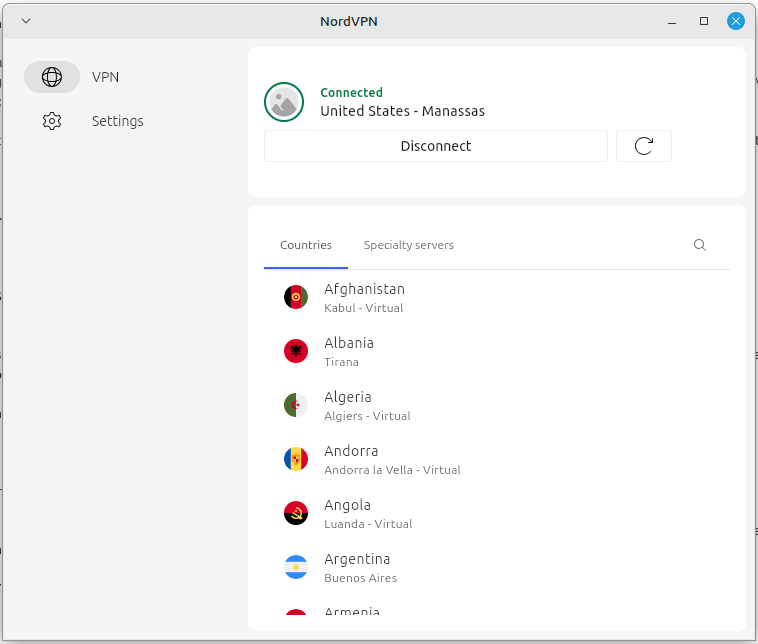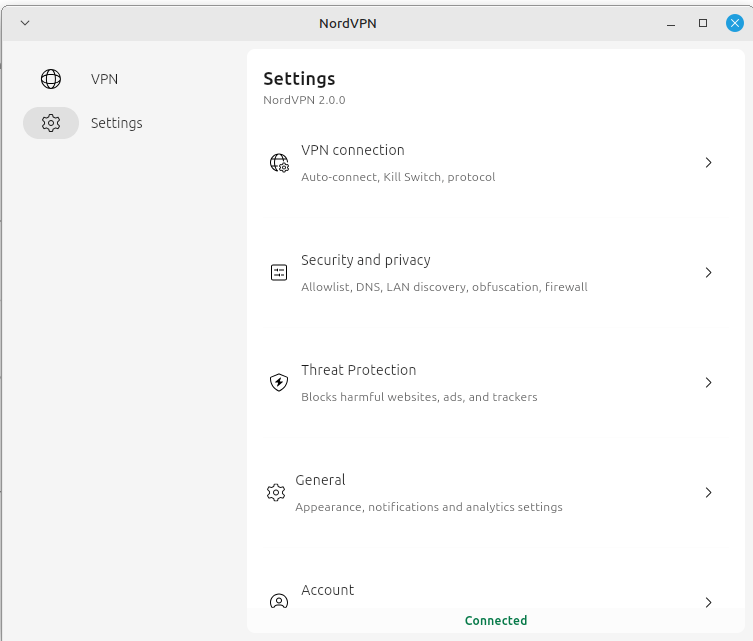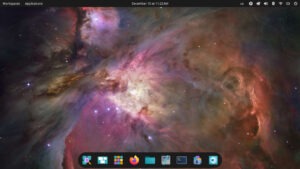In May, NordVPN got full scale on board with Linux when it released a Linux client. We just took it for a spin!

Back in May, the folks at NordVPN announced a new GUI-based app for Linux and as far as I can tell, hardly anyone noticed. I saw the notice from Nord, and I think one article from a tech news site showed up in my RSS feed, making this a pretty ho-hum event.
As recently as 10 years ago, that wouldn’t have been the case. A Linux app from a major service such as NordVPN would’ve been big news. Go back another five years, to 15 years ago, and every open source site on the internet would be running screaming headlines about the arrival of the much anticipated year of the Linux desktop. Back in the aughts, when we Linux users wanted to use some company’s product we had to use the browser app — and often the browser app wouldn’t support Linux either.
These days we’re spoiled. I currently have a Zoom app on my Linux box and on my main laptop, and in the past had the client app for Slack until Slack quit being a thing you needed to have. I even had a Linux app for Microsoft Teams, but got rid of that in 2021 when I quit my corporate job. I think Microsoft discontinued the native Linux app recently but still offer it as a web app that’ll work on Linux.
I’ve had a NordVPN account that I never bothered to use since April, but for this article I decided to activate the account just so I could take advantage of the app, so I could tell you about it. At this point, for full disclosure, I should mention that NordVPN is a FOSS Force affiliate sponsor–so if you click on a link to Nord in this article and end up making a purchase, we’ll get a commission. Now that that’s said, let’s look at NordVPN’s Linux client.
Why You Should Download Nord’s Client First
The first thing I discovered when I tried to hook the company Thelio to Nord’s VPN was that it’s a whole lot easier to do that if you download the app and hook up through that. My original thought was that first I’d get all connected, and make sure everything was OK with my account before I downloaded the app. That didn’t work out, although Nord’s website recognized my sign in, and that I had an account that was paid through April 2027. It even noticed that I hadn’t bothered to connect yet, and presented me with a button to press to make that happen.
But when I hit the button to connect, a new tab opened (success! I thought for an instant) and then I got an error message: “Oops! Something went wrong An unexpected error has occurred. You can now close this window.”
After three tries with the same result, I went to the world’s foremost authority on nearly everything, which of course is not Mr. Peabody anymore but a chatbot, and asked it what to do. Perplexity immediately returned a long list of troubleshooting suggestions, to which I said between gritted teeth, “Frack that.” I went back to Nord’s website and pressed the button to get the Linux desktop client. I was told to open a terminal and was given a command to run.
sh <(wget -qO - https://downloads.nordcdn.com/apps/linux/install.sh) -p nordvpn-gui
Attempting to run this command immediately threw up a red flag, with a warning message telling me that pasting this command into the terminal might be dangerous because it would execute. I clicked through the warning and almost immediately the client opened. Not seeing an obvious "hook up to the VPN now" or a "you are connected" button I then clicked "settings" and "VPN connection." Again, I was thrown into a browser tab and got a "failed" error message.
It's much quicker to get Perplexity to find things on a website than it is for me to find it for myself, so I asked her to find out what I need to do.
She--well, she has a female voice on Android--said that I needed to run:
sudo groupadd nordvpn
And then…
sudo usermod -aG nordvpn $USER
The first command (being a proud snowflake, I like to refer to them as "requests") creates a new user group called "nordvpn" on the system. If the group already exists, it will return an ignorable error. The second request adds the current user to the nordvpn group.
After that, I needed to log out and log back in (or do a reboot) for the group change to take effect.
I did as I was told, went back to settings and clicked to make the connection.
Presto! I was connected to the world through Nord's VPN.
The only thing was that at this point I'd have to tell Nord I wanted to be connected each and every time I booted the computer. The good new is that there's a command for enabling NordVPN's autoconnect feature:
nordvpn set autoconnect on
You might have noticed that I was doing a lot of work in the terminal, making this a client GUI that requires you to use the command line for tons of stuff. How old-school Linux can you get? Don't worry. After you get it installed, it might never need you to open a terminal again.

NordVPN's Client in a Nutshell
Pretty much, NordVPN's Linux client is completely underwhelming… in a good way. Under the heading "VPN," you get a list of Nord's servers located in countries around the world that you can specify. This is good for a variety of reasons. If the server you're using should go down, for instance, you can switch to another server. Also, sometimes you might need for the person on the other end of your internet connection to think you're in a country that you're not -- this lets you do that too.
The "server" tab gives users the ability to connect to specialty servers, such as Tor over VPN. Some of these require activation on Nord's website, some are free and come with your VPN subscription, some might be available "for a few dollars more."
The "settings" section's default is good to go as is, but you might want to give it a look. In addition to accessing account information and connecting and disconnecting with the VPN, the section lets you enable "Threat Protection," a feature that protects you from harmful websites and let's you set some security and privacy features, and a general section where you can do stuff like enable themes.
Wanna learn more? Start here. Tell them Christine sent you.
Christine Hall has been a journalist since 1971. In 2001, she began writing a weekly consumer computer column and started covering Linux and FOSS in 2002 after making the switch to GNU/Linux. Follow her on Twitter: @BrideOfLinux









After the command ‘nordvpn set autoconnect on’, the author complains that the “client GUI that requires you to use the command line for practically everything”.
However, the image immediately following this shows a VPN connection setting list in the GUI, with the first item being ‘Auto-connect’. So, it wasn’t necessary to use the CLI for that command.
I realize this site is called fossforce so one would assume you’d only cover FOSS software, so this may be a dumb question, but are you sure this is foss? Which license are they using? Do they only provide source to customers, or is it in a public repo? If public, what is the URL?
“Linux” client?
What exactly IS a “Linux” client?
Does it run on Fedora?
Does it run on openSUSE Tumbleweed (without breaking the next time Tumbleweed updates)?
Does it have a Flatpak?
Does it have an AppImage?
Or does it just run on Debian and Ubuntu?
That’s NOT a “Linux” client.
Although their blog does say it will “eventually” have a Snap version (most people hate Snaps.)
@richardstevenhack
The article doesn’t tell us much, but if you look at the script they suggest running, it will install a deb or rpm pacakge based on what pacakge manager it finds. It handles apt, zypper, yum, and dnf. So in theory should work on fedora and opensuse…..
Dunno if its FOSS tho….
It’s not a question of “deb or rpm” – it’s a question of whether the app is supported in a native manner on any given distro. Rolling release distros like openSUSE Tumbleweed are particularly difficult to support. I’ve had numerous rpm installed apps fail on the next update from openSUSE because an underlying library was updated. Long term support distros are also subject to this – or the opposite problem, an underlying library is too OLD.
This is an inherent problem with Linux – too many damn distros. This is why AppImages, Flatpaks and Snap were invented.
I won’t touch an app today unless it is supplied as one of those – preferably one or both of the first two – or is directly support by the team running the distro I’m running.
Stop calling things a “Linux client” – which only run on a handful of the most prevalent Linux distros – which are usually the “Big 3” – Debian, Ubuntu, and Fedora. It’s like calling it a “Windows client” if it only runs on Windows XP.
Semantics.
If it only runs on Windows XP, then that would indeed be a windows client. XP is in fact a version of Microsoft Windows.
A client is still a linux client if it will run on any form of linux. There is no requirement to work on every device using a linux kernel to call something a linux client, that is not how words work, sorry.